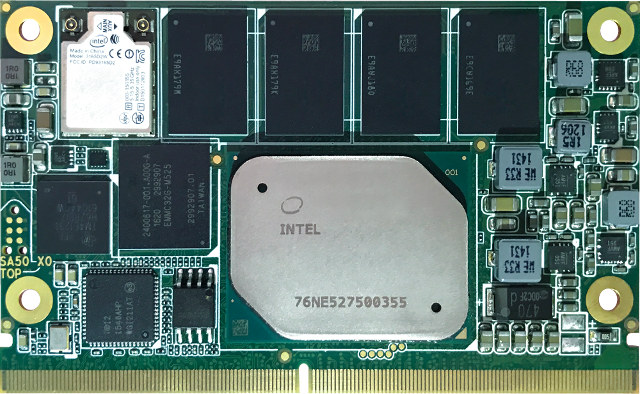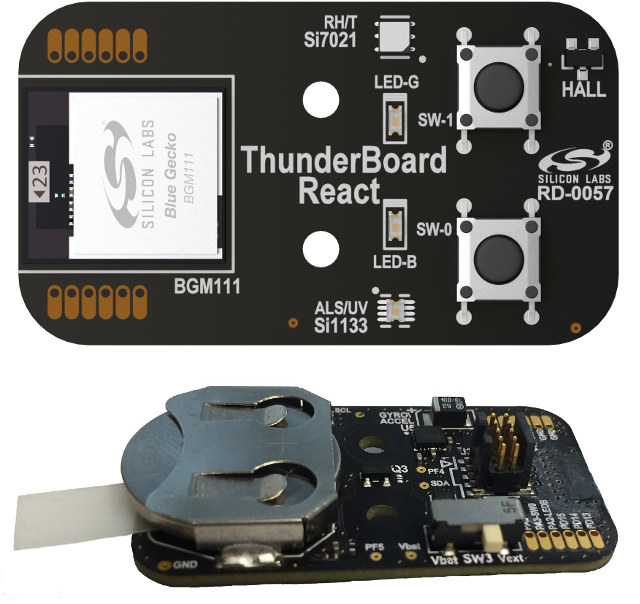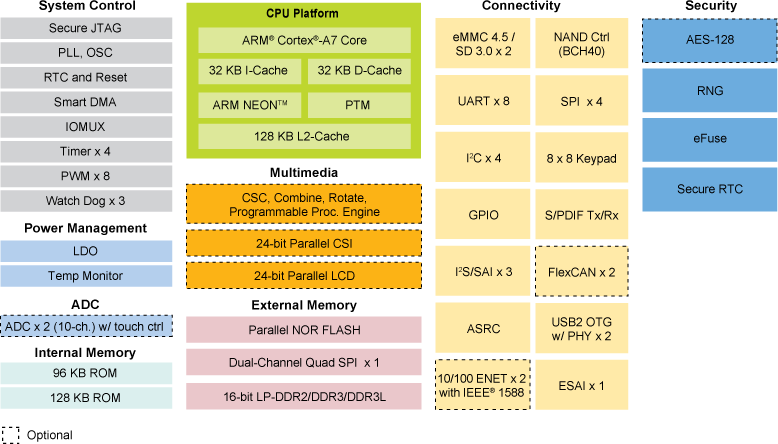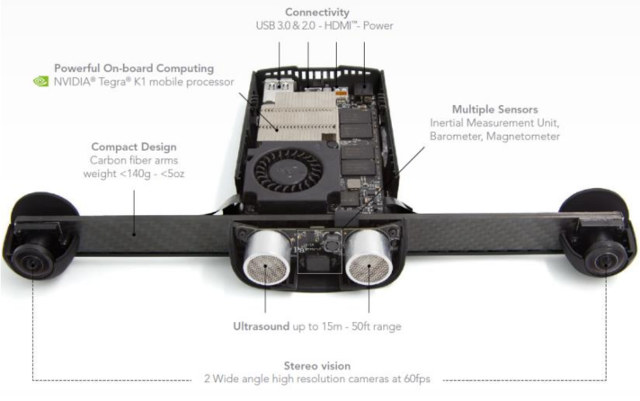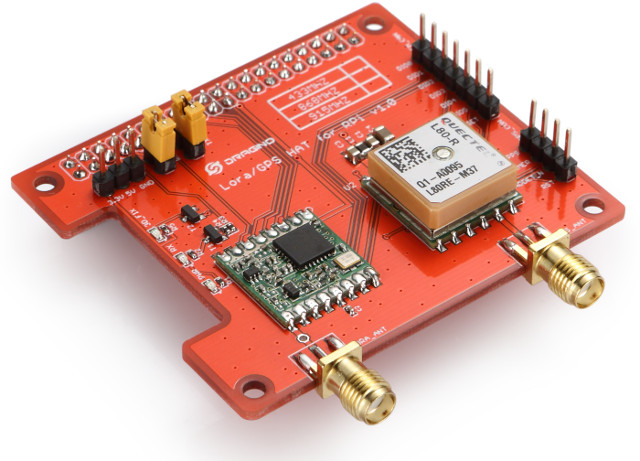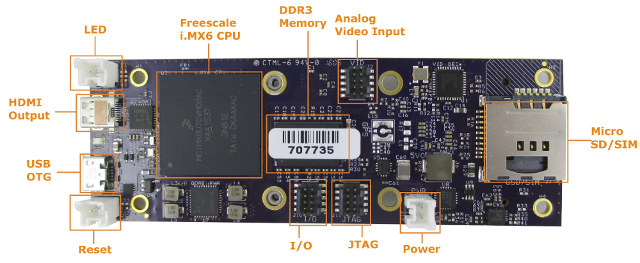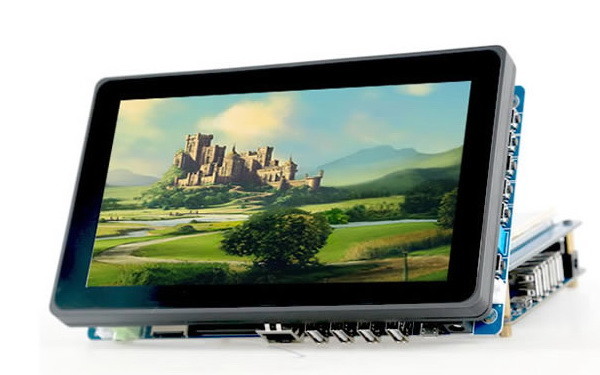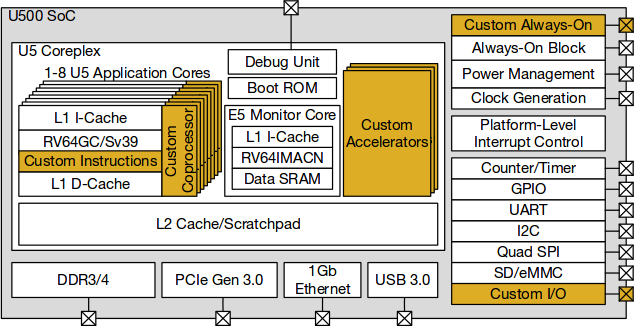congatec, a company specialized in embedded computer modules, single board computers and embedded design and manufacturing services, has just introduced their conga-SA5 system-on-module family compliant with SMARC 2.0 specifications, and powered by the latest Intel Apollo Lake processors. conga-SA5 SoM’s specifications: SoC (one of the list) Intel Atom x7-E3950 quad core processor @ 1.6 / 2.0 GHz with 2MB L2 cache, 18 EU Intel Gen 9 HD Graphics (12W TDP) Intel Atom x5-E3940 quad core processor @ 1.6 / 1.8 GHz with 2MB L2 cache, 12 EU Intel Gen 9 HD Graphics (9W TDP) Intel Atom x5-E3930 dual core processor @ 1.3 / 1.8 GHz with 2MB L2 cache 1MB, 12 EU Intel Gen 9 HD Graphics (6.5W TDP) Intel Celeron N3350 dual core processor @ 1.1 / 2.4 GHz with 1MB L2 cache, 12 EU Intel Gen 9 HD Graphics (6W TDP) Intel Pentium N4200 quad core processor @ […]
Silicon Labs Introduces $29 Thunderboard React Bluetooth 4.2 LE IoT Board and $69 Derby Car Kit
Earlier this summer, Silicon labs launched ThunderBoard React, a Bluetooth 4.2 LE compliant board with sensors and expansion headers for IoT applications based on the company’s BGM111 Bluetooth Smart Module, and to make it much more fun to work with the company has released a Derby Car kit controlled by the board. ThunderBoard React specifications: Bluetooth Module – BGM111 Bluetooth 4.2 compliant module with integrated Tx and Rx antenna, and Cortex M4 MCU @ 38.4 MHz with 32 kB RAM and 256 kB Flash Extra Storage – Footprint for 8Mb external flash storage Sensors – Si7021 relative humidity and temperature, Si1133 UV index and ambient light sensor, Invensense MPU-6500 6-axis gyro/accelerometer, Si7201 hall effect position sensor Expansion – 12 breakout pina to connect to BGM111 GPIOs Debugging – 10-pin mini Simplicity debug connector Misc – 2x momentary buttons, 2x LEDs, power selection switch Power Supply – CR2032 coin cell battery […]
NXP i.MX 6ULL Cortex A7 Processor is the Latest Member of i.MX6 32-bit ARM Processor Family
Freescale first unveiled i.MX6 processor family at CES 2011. Since then NXP has acquired Freescale, and kept working on the processors and even recently unveiled NXP i.MX 6ULL Cortex A7 processor promising 30 percent more power efficiency than its nearest competitors, and designed for “cost-effective solutions for the growing IoT consumer and industrial, mass markets”. NXP i.MX 6ULL key features and specifications: CPU – ARM Cortex A7 core @ up to 528 MHz with 128KB L2 cache Memory I/F – 16-bit DDR3/DDR3L, LPDDR2 memory support Storage I/F – 8/16-bit parallel NOR flash / PSRAM, dual-channel Quad-SPI NOR flash, 8-bit raw NAND flash with 40-bit ECC, 2x MMC 4.5/SD 3.0/SDIO Port Display & Camera I/F Parallel LCD Display up to WXGA (1366×768) Electrophoretic display controller support direct-driver for E-Ink EPD panel, with up to 2048×1536 resolution at 106 Hz 8/10/16/24-bit Parallel Camera Sensor Interface Peripherals 2x USB 2.0 OTG, HS/FS, Device […]
Parrot S.L.A.M Dunk is a Ubuntu & ROS Computer with 3D Depth Cameras for Drones & Robots
Parrot and Canonical have partnered to develop the Parrot S.L.A.M.dunk development kit for the design of applications for autonomous navigation, obstacle avoidance, indoor navigation and 3D mapping for drones and robots, and running both Ubuntu 14.04 and ROS operating systems. The name of the kit is derived from its “Simultaneous Localization and Mapping algorithm” (S.L.A.M) allowing for location without GPS signal. Parrot S.L.A.M Dunk preliminary specifications: SoC – NVIDIA Tegra K1 processor Camera – Fish-eye stereo camera with a 1500×1500 resolution at 60fps Sensors – Inertial-measurement unit (IMU), ultrasound sensor up to 15 meters range, magnetometer, barometer Video Output – micro HDMI USB – 1x micro USB 2.0 port, 1x USB 3.0/2.0 port Weight – 140 grams Parrot S.L.A.M dunk can be fitted various drones and robotic platforms such as quadcopters and fixed-wings, rolling robots and articulated arms using mounting kits. The computer module is then connected to the host […]
Dragino LoRa/GPS HAT Board for Raspberry Pi Sells for $32
There are several ways to play with LoRaWAN protocol on the Raspberry Pi including RisingHF Discovery kit or Cooking Hacks LoRa Shield for Raspberry Pi, but the latter requires you to spend close to $100 just for the shield, the complete Lora discovery kit costs close to $400. Dragino Tech LoRa/GPS HAT board should be a more cost effective way to get started with LoRa on Raspberry Pi, as it sells for $32 + shipping on Tindie. Dragino LoRa/GPS HAT specifications: Connectivity LoRa Semtech SX1276/SX1278 transceiver @ 433/868, or 915 MHz (Country dependent, pre-configured in the factory) 168 dB maximum link budget. +20 dBm – 100 mW constant RF output vs. +14 dBm high efficiency PA. Programmable bit rate up to 300 kbps. GPS L80 GPS module based on Mediatek MT3339 SoC Horizontal Position Accuracy: autonomous <2.5 m CEP. TTFF@-130dBm with EASY (AGPS): Cold Start <15s,Warm Start <5s,Hot start <1s; […]
Gateworks Ventana GW5530 SBC is Designed for Drones, Robots, and Digital Signage
Gateworks Ventana is a family of boards based on NXP i.MX6 processor designed for embedded applications, and often include one or more mini PCIe ports for expansion. Their latest single board computer – Ventana GW5530 – is powered by an NXP i.MX 6Dual processor coupled with 512MB RAM, 256MB storage, a mini PCIe port, a micro SD / SIM card slot, micro HDMI output, and some I/Os. Ventana GW5530 specifications: SoC – NXP i.MX6 Dual Core ARM Cortex-A9 processor @ 800MHz with Vivante 2D and 3D GPUs System Memory – 512MB DDR3 (Up to 2GB as option) Storage – 256MB flash (Up to 2GB as option), micro SD/SIM card slot, serial configuration EEPROM Video & Audio Output – micro HDMI 1.4 port Connectivity – Optional u-blox EVA-M8M GPS Receiver with MMCX or u.FL Antenna Connector USB – 1x micro USB 2.0 OTG Port Sensors – 9-axis inertial module (accelerometer/gyro/magnetometer) Expansion […]
sModule SBC-x6818 Development Kit based on Samsung S5P6818 Processor Includes a 7″ Touchscreen
For some reasons, Samsung S5P4418 and S5P6818 quad and eight Cortex A53 core processors – likely made by Nexell – have been quite popular with embedded systems companies based in China. So after Graperain, Boardcon, and FriendlyARM, there’s at least one another company offering solutions with either processor, as sModule, a subsidiary of CoreWind, has now launched systems-on-module, single board computers, and development kits with the 64-bit ARM SoCs. In this post, I’ll cover one of their development kit including their CORE6818 CPU module, a baseboard, and an optional 7″ capacitive touch display.. sModule SBC-x6818 development kit specifications: CORE6818 CPU module SoC – Samsung S5P6818 octa-core ARM Cortex A53 processor @ 1.4 to 1.6 GHz with Mali-400MP 3D GPU System Memory – 1GB DDR3 (2GB optional) Storage – 8GB eMMC Flash (4 & 16GB optional) Ethernet – Realtek RTL8211E Gigabit Ethernet transceiver 180-pin “interface” to baseboard Power Supply – 3.7 […]
SiFive Introduces Freedom U500 and E500 Open Source RISC-V SoCs
Open source used to be a software thing, with the hardware design being kept secret for fear of being copied, but companies such as Texas Instruments realized that from a silicon vendor perspective it would make perfect sense to release open source hardware designs with full schematics, Gerber files and SoM, to allow smaller companies and hobbyists, as well as the education market, normally not having the options to go through standard sales channels and the FAE (Field Application Engineer) support, to experiment with the platform and potentially come up with commercial products. That’s exactly what they did with the Beagleboard community, but there’s still an element that’s closed source, albeit documented: the processor itself. But this could change soon, as SiFive, a startup founded by the creators of the free and open RISC-V architecture, has announced two open source SoCs with Freedom U500 processor and Freedom E300 micro-controller. Freedom […]


